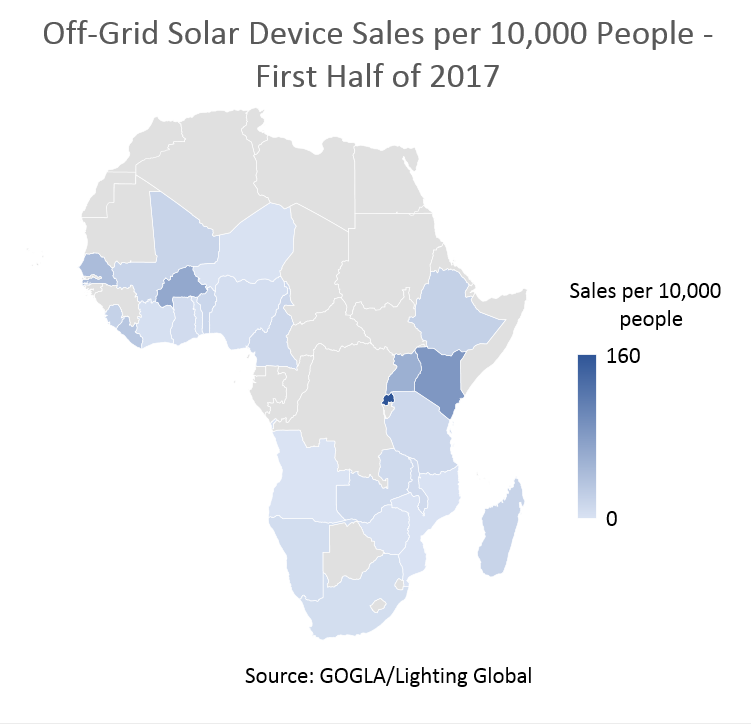Blog

Sub-Saharan Africa has arisen as a prime market for off-grid solar devices, but the number of sales varies wildly throughout the region. Kenya has been one of the biggest success stories with more than 320,000 solar home systems sold so far, while Tanzania is at around 40,000 sales, and in many other countries the number of sales is only in the hundreds or thousands. What factors explain these huge disparities?
Different countries have pursued different strategies for building up their off-grid solar markets. Kenya and Tanzania have received the most attention from experts so far. Kenya’s rapid growth in off-grid solar has been largely driven by the private sector, while Tanzania’s market has increased more slowly, driven by the government and foreign donors. Researchers have proposed numerous explanations for these divergent outcomes, including the size of the middle class, the business culture, population density, the speed of national electrification, and the mobile money ecosystem.
I examined these explanations in a statistical analysis of off-grid solar sales in sub-Saharan Africa. The dataset included 26 countries in total, going beyond the usual suspects of Kenya and Tanzania. The sales data was compiled by the Global Off-Grid Lighting Association (GOGLA) and the World Bank’s Lighting Global project. It includes all types of off-grid solar products from a single solar light to a solar home system. While the data is limited to devices sold by GOGLA member companies, which cover about a third of total sales, it can be seen as a proxy for the wider sector.
When controlling for population size, the top five countries for off-grid solar sales in the first half of 2017 were Rwanda, Kenya, Burkina Faso, Uganda, and Senegal (see map). What makes these countries so successful? My analysis revealed that two potential explanations have a statistically significant relationship with the amount of off-grid solar sales per capita: business culture and population density.

First, I looked at the World Bank’s 2017 Doing Business rankings, which measure whether a country’s regulatory environment is conducive to the starting and operation of a local firm. One would expect that the better the ranking, the higher the sales of off-grid solar devices because more companies will enter and remain in the market. There is indeed a statistically significant relationship. Rwanda and Kenya have among the best Doing Business rankings and are the top two countries for sales per capita, while countries with worse rankings have lower levels of sales per capita. The relationship is not perfect however, as there are some countries, like Zambia and South Africa, where it is relatively easy to do business, but off-grid solar sales have not taken off. For the statistical-minded readers: note that I used the log10 of the sales per capita data to achieve a linear fit, and the regression produced a p-value of 0.046 and an R-squared of .16, meaning that about 16% of the variation in sales is explained by the Doing Business rankings.
Next, I looked at the impact of the number of people per square kilometer and found a statistically significant relationship with off-grid sales per capita. Presumably, when a country has a higher population density, it is easier for off-grid solar companies to access customers and build simpler supply chains to achieve more sales. Rwanda is the clear example here, because it is the densest country and has the most sales per capita. Note, I again used the log10 of the sales per capita data, and the regression had a p-value of 0.02 and R-squared of 0.21.
The other three factors I examined – the size of the middle class, the speed at which the national electric grid is expanding, and the prevalence of mobile bank accounts – resulted in no statistically significant relationships, though in some cases this may be due to data availability challenges. Forming a better understanding of the differences in off-grid solar sales can inform policymakers in less successful countries about which factors to focus on to emulate the more successful countries. The stakes are high, as almost 590 million people lack access to electricity in sub-Saharan Africa and off-grid solar could help fill some of that gap.
Joel Jaeger is an M.A. candidate concentrating in Energy, Resources, and Environment at the Johns Hopkins School of Advanced International Studies (SAIS). This blog is based off a research paper written for a course on energy access.
